2024中考英语试题研究 第二部分 专题一 第2讲 动词的时态 课件(共63张PPT)
文档属性
| 名称 | 2024中考英语试题研究 第二部分 专题一 第2讲 动词的时态 课件(共63张PPT) |  | |
| 格式 | pptx | ||
| 文件大小 | 632.4KB | ||
| 资源类型 | 教案 | ||
| 版本资源 | 通用版 | ||
| 科目 | 英语 | ||
| 更新时间 | 2023-12-19 20:28:59 | ||
图片预览

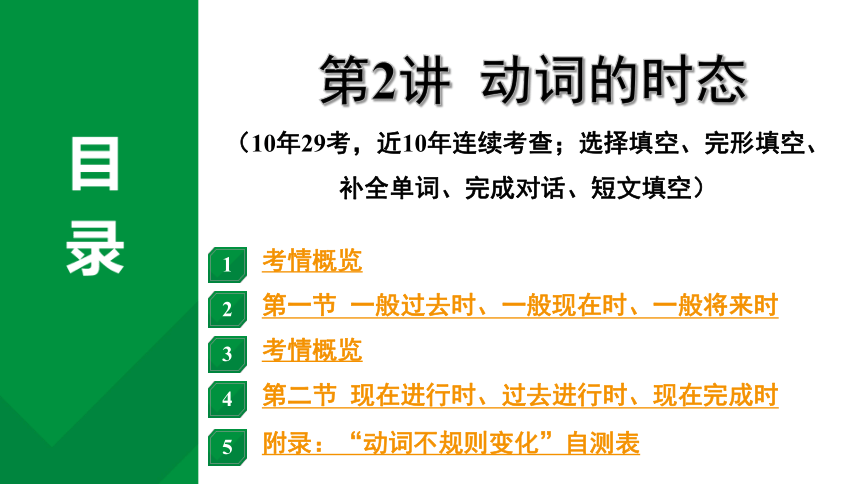
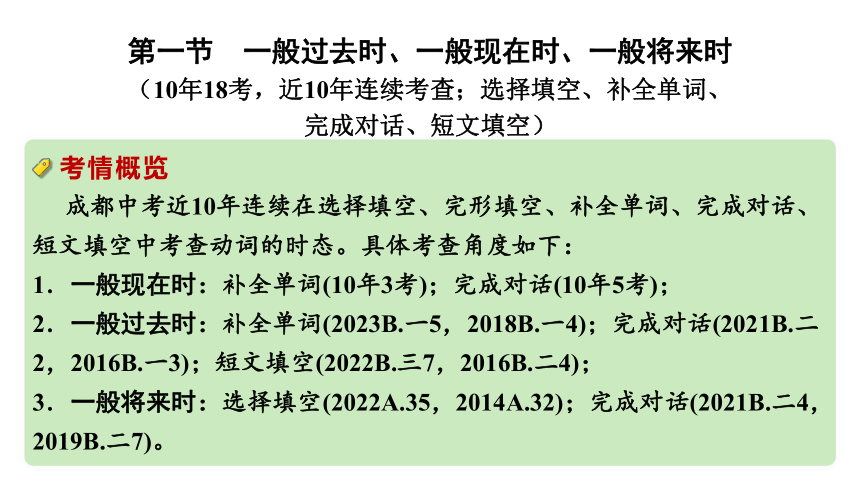
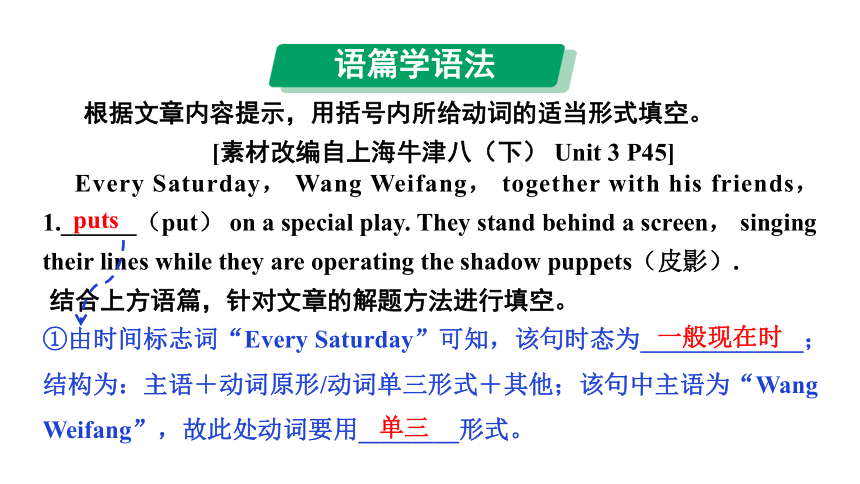

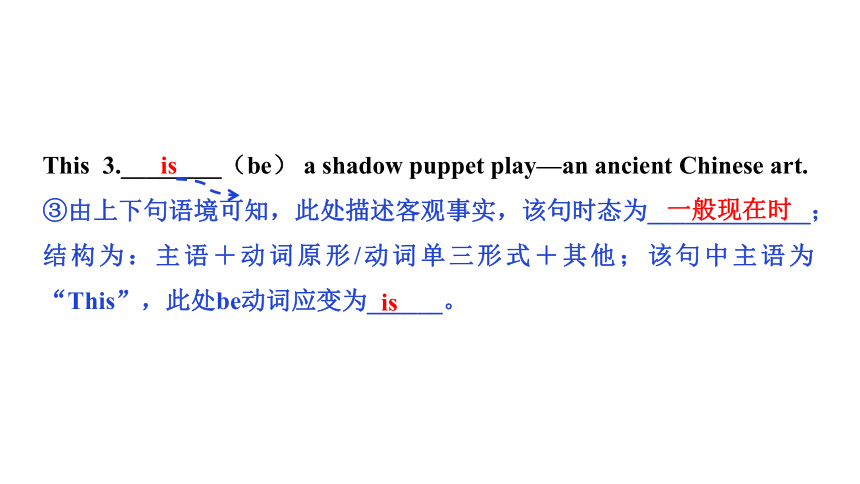
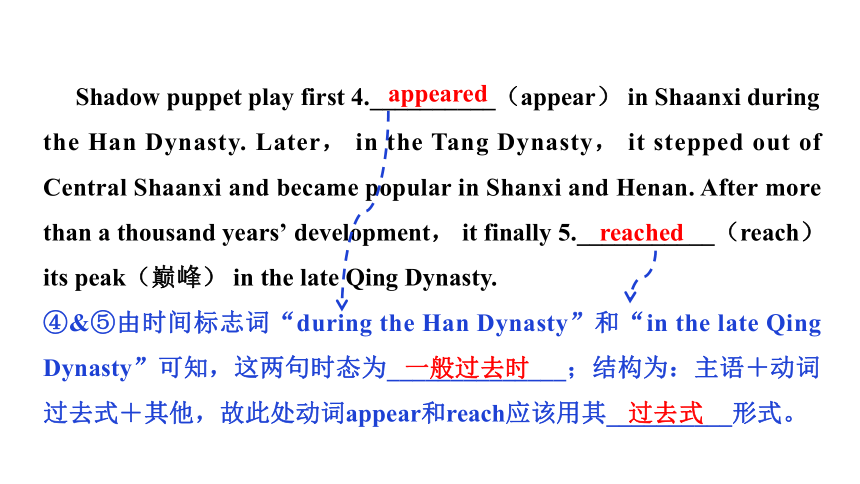
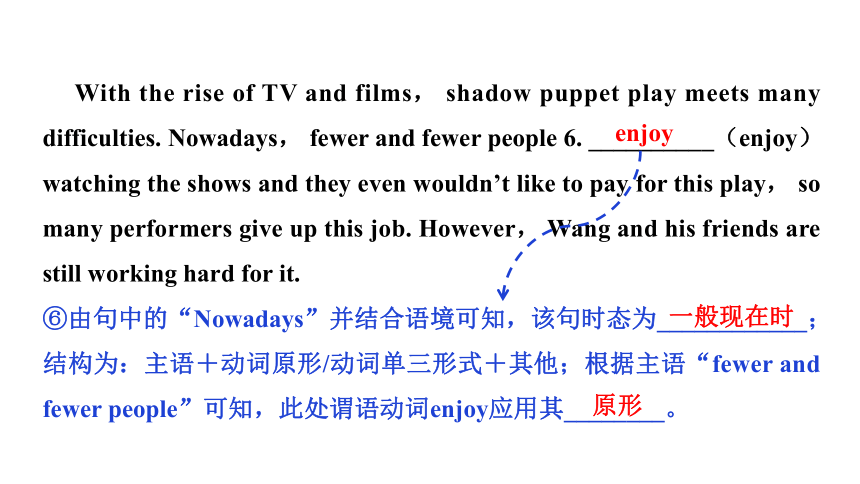
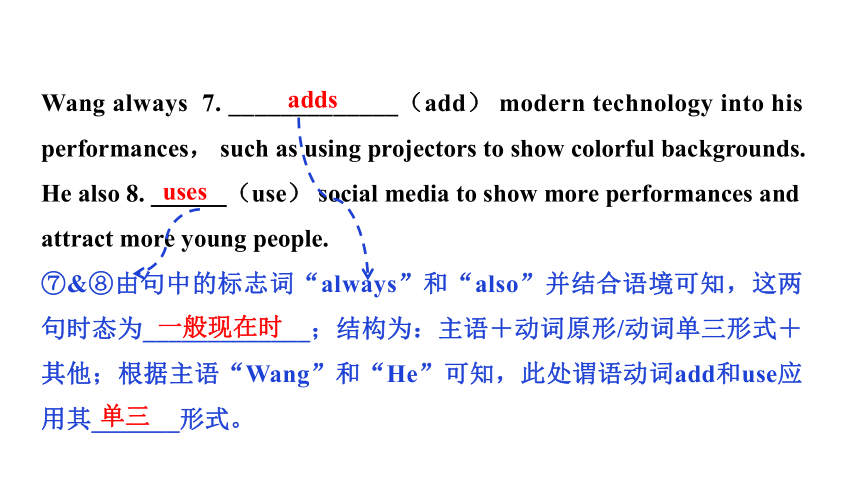
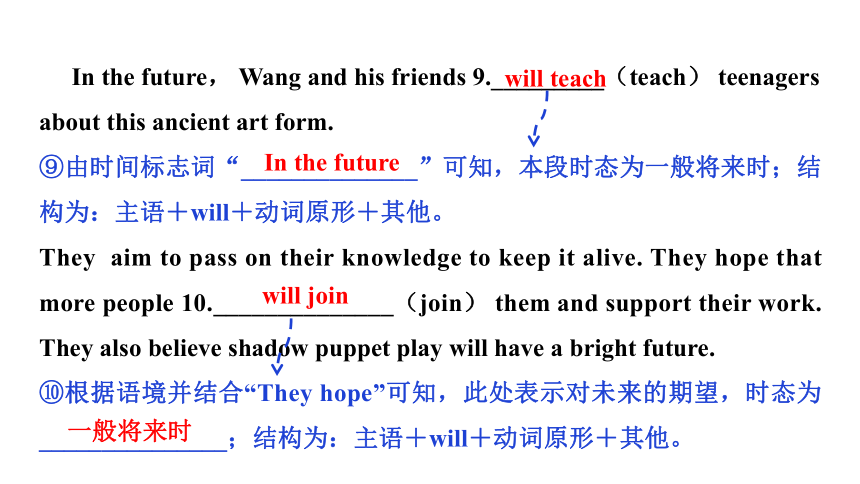

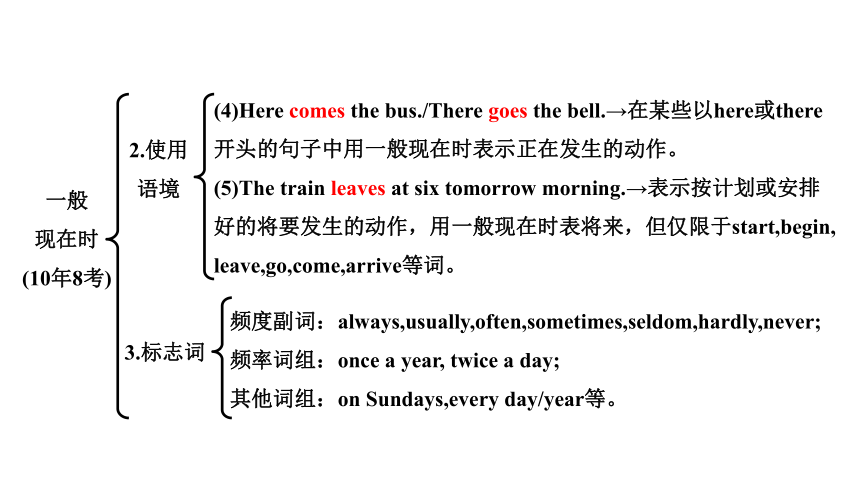
文档简介
(共63张PPT)
专 题 一
形式多变的动词
第2讲 动词的时态
3
考情概览
(10年29考,近10年连续考查;选择填空、完形填空、补全单词、完成对话、短文填空)
1
考情概览
5
附录:“动词不规则变化”自测表
2
第一节 一般过去时、一般现在时、一般将来时
4
第二节 现在进行时、过去进行时、现在完成时
考情概览
成都中考近10年连续在选择填空、完形填空、补全单词、完成对话、短文填空中考查动词的时态。具体考查角度如下:
1.一般现在时:补全单词(10年3考);完成对话(10年5考);
2.一般过去时:补全单词(2023B.一5,2018B.一4);完成对话(2021B.二2,2016B.一3);短文填空(2022B.三7,2016B.二4);
3.一般将来时:选择填空(2022A.35,2014A.32);完成对话(2021B.二4,2019B.二7)。
第一节 一般过去时、一般现在时、一般将来时
(10年18考,近10年连续考查;选择填空、补全单词、完成对话、短文填空)
Every Saturday, Wang Weifang, together with his friends, 1.______(put) on a special play. They stand behind a screen, singing their lines while they are operating the shadow puppets(皮影).
结合上方语篇,针对文章的解题方法进行填空。
①由时间标志词“Every Saturday”可知,该句时态为_____________;结构为:主语+动词原形/动词单三形式+其他;该句中主语为“Wang Weifang”,故此处动词要用________形式。
puts
一般现在时
单三
语篇学语法
根据文章内容提示,用括号内所给动词的适当形式填空。
[素材改编自上海牛津八(下) Unit 3 P45]
Light 2._______(send) the shadows of the puppets on a white screen. People sit before the screen, listening and watching the shadows moving according to the lines.
②由上下句语境可知,此处描述的是皮影戏是如何形成的,是客观事实,该句时态为____________;结构为:主语+动词原形/动词单三形式+其他;该句中主语为“Light”,故此处send要变为________形式。
sends
一般现在时
单三
This 3.________(be) a shadow puppet play—an ancient Chinese art.
③由上下句语境可知,此处描述客观事实,该句时态为_____________;结构为:主语+动词原形/动词单三形式+其他;该句中主语为“This”,此处be动词应变为______。
is
一般现在时
is
Shadow puppet play first 4.__________(appear) in Shaanxi during the Han Dynasty. Later, in the Tang Dynasty, it stepped out of Central Shaanxi and became popular in Shanxi and Henan. After more than a thousand years’ development, it finally 5.___________(reach) its peak(巅峰) in the late Qing Dynasty.
④&⑤由时间标志词“during the Han Dynasty”和“in the late Qing Dynasty”可知,这两句时态为______________;结构为:主语+动词过去式+其他,故此处动词appear和reach应该用其__________形式。
appeared
一般过去时
过去式
reached
With the rise of TV and films, shadow puppet play meets many difficulties. Nowadays, fewer and fewer people 6. __________(enjoy) watching the shows and they even wouldn’t like to pay for this play, so many performers give up this job. However, Wang and his friends are still working hard for it.
⑥由句中的“Nowadays”并结合语境可知,该句时态为____________;结构为:主语+动词原形/动词单三形式+其他;根据主语“fewer and fewer people”可知,此处谓语动词enjoy应用其________。
enjoy
一般现在时
原形
Wang always 7. _____________(add) modern technology into his performances, such as using projectors to show colorful backgrounds. He also 8. ______(use) social media to show more performances and attract more young people.
⑦&⑧由句中的标志词“always”和“also”并结合语境可知,这两句时态为_____________;结构为:主语+动词原形/动词单三形式+其他;根据主语“Wang”和“He”可知,此处谓语动词add和use应用其_______形式。
一般现在时
单三
adds
uses
In the future, Wang and his friends 9._________(teach) teenagers about this ancient art form.
⑨由时间标志词“______________”可知,本段时态为一般将来时;结构为:主语+will+动词原形+其他。
They aim to pass on their knowledge to keep it alive. They hope that more people 10.______________(join) them and support their work. They also believe shadow puppet play will have a bright future.
⑩根据语境并结合“They hope”可知,此处表示对未来的期望,时态为_______________;结构为:主语+will+动词原形+其他。
In the future
will teach
一般将来时
will join
课标知识导图
动词的时态(第一节)(10年18考):①一般现在时(10年8考) ②一般过去时(10年6考)
③一般将来时(10年4考)
一般
现在时
(10年8考)
1.结构
I often visit my aunt’s house.→主语+am/is/are或动词原形/动词
单三形式+其他。
2.使用语境
(1)Lily usually plays chess with her brother.→表现阶段经常性或习惯性的动作。
(2)Light travels faster than sound.→表客观事实或普遍真理。
(3)If it doesn’t rain, we’ll go to the park.→在以if,unless, as soon as,
when, once,until等引导的条件状语从句中,用一般现在时表将来。
一般
现在时(10年8考)
2.使用语境
(4)Here comes the bus./There goes the bell.→在某些以here或there
开头的句子中用一般现在时表示正在发生的动作。
(5)The train leaves at six tomorrow morning.→表示按计划或安排好的将要发生的动作,用一般现在时表将来,但仅限于start,begin,
leave,go,come,arrive等词。
3.标志词
频度副词:always,usually,often,sometimes,seldom,hardly,never;
频率词组:once a year, twice a day;
其他词组:on Sundays,every day/year等。
一般
过去时
(10年6考)
1.结构
Last week, I visited my aunt’s house.→主语+was/were或动词过去式+其他。
2.使用语境
(1)We went to the city library yesterday.→表过去某段时间里所发生的动作或存在的状态,或过去经常发生的动作。
(2)He has learned a lot about Chinese culture since he came to China.→在since引导的时间状语从句中,主句用现在完成时,从句用一般过去时。
(3)What was the final score (说话时比分已经出来了)→有些句子中没有明确的表示过去时间的状语,但实际上是指过去发生的动作或存在的状态,应用一般过去时。
一般
过去时(10年6考)
3.标志词
yesterday类:yesterday, the day before yesterday;
ago词组:three days ago, two months ago;
last词组:last week, last night;
其他:just now, in the past, in 1995等。
一般
将来时(10年4考)
1.结构
I will visit my aunt’s house tomorrow.
→主语+will+动词原形或be going to+动词原形+其他。
2.使用语境
(1)I will go hiking with my friends tomorrow.→表将来发生的动作或存在的状态。
一般
将来时(10年4考)
2.使用语境
(2)Look at the dark clouds. There is going to be a storm.
(客观迹象)→be going to+动词原形,表示计划、打算做某事,表示已决定的、很可能发生的事,或有某种迹象表明要发生的事。
(3)Fish will die without water.→表示某种必然的趋势。
(4)主将从现。[详见本导图一般现在时③]
tomorrow类:tomorrow, the day after tomorrow;
next词组:next week, next year;
in+一段时间/将来的年份:in three days, in 2035,in the future;
this类:this evening等。
3.标志词
考情概览
成都中考近10年连续在选择填空、完形填空、补全单词、完成对话中考查动词的时态,具体考查角度如下:
1.现在进行时:选择填空(10年3考);
2.过去进行时:选择填空(10年3考);
3.现在完成时:选择填空(2020A.31,2015A.46);完形填空(2014A.56);补全单词(2020B.一5);完成对话(2015B.一5)。
第二节 现在进行时、过去进行时、现在完成时
(10年11考,近10年连续考查;选择填空、完形填空、补全单词、完成对话)
语篇学语法
根据文章内容提示,用括号内所给动词的适当形式填空。
[素材改编自北师 八(下) Unit 6 Lesson 16 P112]
I accepted the invitation of my friend Marty and visited him last weekend. His parents were on business that day. “Please keep your voice down.
My grandmother 1.__________________(sleep) in her bedroom.” As I walked into his home,he came to tell me.
结合上方语篇,针对文章的解题方法进行填空。
①由上句“keep your voice down”可知,此处描述的是Marty的原话,表示祖母正在睡觉,时态为______________;结构为:主语+am/is/are +v. ing+其他;此句中主语为“My grandmother”,系动词用___。
After a short conversation, Marty asked me if I was hungry. I told him that I was.Then Marty went back to the kitchen to cook a snack for us.
现在进行时
is
is sleeping
I 2._______________(wait) for him in the living room when I heard a woman’s loud voice from a room down the hall.
②由句中的“heard”并结合语境可知,此处表示过去的某个时间点正在发生和进行的动作,时态为___________;结构为:主语+was/were +v. ing+其他;此句中主语为I,系动词用____________。
“What’s your name?” “You can call me Nick.” I softly answered. “What are you doing?”she continued.
过去进行时
was
was waiting
“I 3.________________(visit) Marty.”
③由“she continued”可知,此处是对上句“What are you doing?”做出的回答,时态为________________;结构为:主语+am/is/are+v. ing+其他;此句中主语为I,系动词用__________。
While I 4._______________(think) about whether I should visit her in her room or not, she asked me for a biscuit.
④由句中的“asked”并结合语境可知,此处表示当时正在思考,时态为_______________;结构为:主语+ was/were+v. ing+其他;此句中主语为I,系动词用_________。
现在进行时
am
am visiting
过去进行时
was
was thinking
She sounded a bit angry after asking a few times. I went to find Marty in the kitchen.
“Look! I 5.________________(cook) so many biscuits up to now. Have a taste!”
⑤由时间标志词“up to now”及语境可知,此处表示过去的动作对现在造成的影响和结果,时态为___________;结构为:主语+ have/has +done +其他;此句中主语为I,助动词用__________。
He showed me the biscuits with different shapes. I told him about what had just happened. “Do you see my grandma?
现在完成时
have
have cooked
Her room is on the second floor,” he said with a smile. “No, but I hear her voice. She 6._____________(ask) for biscuits for several times in the last few minutes.” I felt a little surprised at his question.
⑥由时间标志词“for several times”可知,此处时态为 __________;结构为:主语+have/has+done+其他;此句中主语为She,助动词用____。
Marty asked me to follow him to that room. He opened the door but nobody was there.
现在完成时
has
has asked
Then I noticed that a big bird 7.______________(stand) by the window. It looked at me and said, “I want a biscuit. I want a biscuit!” At that moment, I understood that voice was from the big bird.
⑦由句中“noticed”并结合语境可知,此处表示过去时间点,看见一只鸟儿正站在窗边,时态为_______________;结构为:主语+ was/were + v. ing+其他;此句中主语为 a big bird,系动词用________。
过去进行时
was
was standing
课标知识导图
动词的时态(第二节)(10年11考):①现在进行时(10年3考) ②过去进行时(10年3考)
③现在完成时(10年5考)
现在
进行时(10年3考)
1.结构
I am visiting my grandparents in the countryside now.
→主语+am/is/are+v.-ing+其他。
2.使用语境
(1)A: What are you doing
B:I am watching an interesting movie.→表此时此刻正在进行的动作。
(2)They are studying hard these days for the exam.→表一段时间内一直做的事情或现阶段正在进行的动作或持续的状态。
(3)My father is leaving for Chengdu on business next week.
→表计划或者安排好的将来要做的事情,此类动词有come,go,
leave,fly,start,arrive等。
(4)They are coming.→be doing,表示将来,常用于这种结构的动词有go,come,leave,stay,start, begain等,表示即将发生或者安排好要做的事情。
现在
进行时(10年3考)
2.使用语境
3.标志词
now, at the moment,look,listen, these days,at present, when/while从句等
(1)He was sweeping the floor at ten yesterday.→表过去某一时刻或阶段正在进行的动作。
(2)She was reading books while her daughter was drawing pictures.
→表一个动作发生时,另外一个动作正在进行,常与when,while,
as引导的时间状语从句连用。
过去
进行时(10年3考)
2.使用语境
3.标志词
then, at this time yesterday, at that time, at ten yesterday,标志词when/while引导的表过去时间的状语从句等
1.结构
I was visiting my grandparents in the countryside at this time yesterday.→主语+was/were+v.-ing+其他。
(1)He has already cleaned the room.→表示从过去某一时刻持续到现在的动作或状态对现在造成的影响或后果。
(2)Chinese paper cutting has been a popular art since ancient times.→表示从过去开始持续到现在的动作或状态,也许还要持续下去,常和for,since连用,表示持续的动作或状态,多为延续性动词。
现在
完成时(10年5考)
2.使用语境
1.结构
I have visited my grandparents in the countryside twice this month.结构→主语+have/has+done+其他。
3.标志词
yet, ever,already, so far, in the past three years,for+时间段,since+时间点/从句等
现在
完成时(10年5考)
4.拓展
(1)have gone to已去某地(未回); have been to曾去过某地(已回);
have been in已经在某地
(2)He has kept my storybook for two weeks.→特殊用法:短暂性
动词(瞬间动词)可用于完成时,但不能与时间段(for…/since...)连用,如果句中有时间段,需要将短暂性动词转换为延续性动词。
随堂检测
基础训练
1. (2023成都A.38)I am sorry I didn’t answer your phone because I _______ the piano at that time.
A. played B. was playing C. am playing
2. (2022成都A.35)In the future, vocational(职业的)students
_________ it easier to get jobs.
A. found B. have found C. will find
B
C
3. (2021成都A.34)The spirit of ox(牛)_________an important role for China’s development this year.
A. is playing B. was playing C. played
4. (2020成都A.31)Bob, you___________ in this city since 2018. How do you like it?
A. lived B. live C. have lived
5. (2019成都A.36)Be quiet! The students _________ an English exam.
A. take B. are taking C. will take
A
C
B
6. (2018成都A.36)Yesterday, I _________ the subway home when I suddenly found I was on the wrong line.
A. took B. was taking C. had taken
7. —We cannot change our past, but we can try to change our future.
—It’s true. The best thing for tomorrow is that we __________ our best.
A. are trying B. will try C. tried
8. Chinese culture_____other countries in the world for thousands of years.
A. influences B. influenced C. has influenced
B
A
C
9. Not only I but also my parents________forward to visiting the Chengdu Museum in June.
A. were looking B. are looking C. will look
10. If it rains this evening, Charlie___________ inside the house with his parents instead of doing outdoor sports.
A. stays B. stayed C. will stay
11. It’s said that there _________ some labor clubs at school! I can’t wait to join them!
A. will be B. was C. has been
B
C
A
12. In the geography class, our teacher tells us that the earth_________ around the sun.
A. moved B. moves C. was moving
13. At six o’clock yesterday afternoon, my mother _______for me outside the school gate.
A. waits B. waited C. was waiting
14. Mr. Smith __________ at the Natural History Museum for more than 10 years, so he knows a lot about insects.
A. is working B. has worked C. was working
B
C
B
15. —I can’t get in touch with Cindy. I’m a little worried.
—Take it easy. I noticed she _________ stories to the kids in the classroom when I passed by.
A. tells B. is telling C. was telling
16. —Mom, I didn’t do well in this math competition.
—It doesn’t matter, my son. Just keep working hard, and you________ sooner or later.
A. succeed B. have succeed C. will succeed
C
C
17. I _________China for three months but this is the first time I’ve ever tried on hanfu.
A. have been in B. have been to C. have gone to
18. —Excuse me, may I talk with Doctor Li now?
—Look! He __________ the medical test results to his patient. Please wait a moment.
A. explains B. explained C. is explaining
A
C
19. Carmen, together with her classmates, often ________ to the old people’s home to help the old clean up the houses and wash their clothes.
A. go B. goes C. went
20. —It is said that some kids_________ their parents for a long time in this village.
—Yes. We should care more about these stay at home children.
A. leave B. left C. have left
B
C
21. —What are you preparing for the Spring Festival?
—I _________ the house and making some cards for my friends.
A. am cleaning B. was cleaning C. will clean
22. —Where is William? I haven’t seen him for three days.
—He _________ Chengdu, and he will come back after Friday.
A. has been to B. has gone to C. will go
23. —What did you do last holiday?
—I __________ at a local park to help clean the rubbish near the lake.
A. volunteer B. have volunteered C. volunteered
A
B
C
24. Cindy didn’t come to our activities. She _________for the coming speech competition.
A. prepares B. is preparing C. was preparing
25. So far my hometown ___________many trees in the desert to stop the wind from blowing sand away.
A. plants B. have planted C. will plant
C
B
语篇提能
Passage
break change decide difference describe develop finish interest look refuse start work
[美育·欣赏艺术]David Ambarzumjan is a strange painter. He paints landscape (风景画) art works and then 1._______them himself. But he is not crazy. He is 2.______________on a series(系列) called “Brushstrokes(一笔) in Time” now. It’s all about showing the same place or landscape at two 3.___________times.
breaks
working
different
The series started out in 2018. In the beginning, they were just paintings of brushstrokes 4. ______________natural landscapes. But the German artist wanted to show how beautiful and different our planet was.
Soon after, the artist 5._________to go into this theme more deeply.
break change decide difference describe develop finish interest look refuse start work
describing
decided
break change decide difference describe develop finish interest look refuse start work
He wanted to show how the Earth has 6._________over time. “I’ve always been 7.______________ in time travel in books and TV series. I felt like I could use the brushstroke to look into the same place at a different time,” said David.
For each of his work, he first 8._______________a painting of a given landscape.
changed
interested
finishes
He then paints over the landscape with a huge brushstroke. These large strokes show what the same landscape was like in the past. He may also imagine what the place will 9._________like in the future.
People love these brushstroke paintings a lot. The artist has 10.____________ quite a large online and social media followings so far!
break change decide difference describe develop finish interest look refuse start work
look
developed
语篇研读
What:介绍了德国艺术家David 的“Brushstrokes in Time”系列作品,他通过在自己的风景画上添加巨大的笔触,展示了同一地点在不同时间的变化。
Why:引导学生关注自然环境的变化,提高学生的创新能力和艺术表现能力。
语篇研读
How:
①文体特征:说明文。
②语言特点:在描述同一地点在不同时间的变化时,作者运用多种时态,突出了David创作的主题和目的,如“These large strokes show what the same landscape was like in the past. He may also imagine what the place will look like in the future.”。
1. AAA型
动词原形 过去式 过去分词 含义
cost ① 花费;需付费
cut ② 砍,剪,切,割
fit ③ 适合;合身;安装
hurt ④ (使)疼痛;受伤
hit ⑤ (用手或器具)击;打;碰撞
let ⑥ 允许;让
put ⑦ 放
cost
cost
cut
cut
fit/fitted
fit/fitted
hurt
hurt
hit
hit
let
let
put
put
附录:“动词不规则变化”自测表
动词原形 过去式 过去分词 含义
read ⑧ 读;阅读;朗读
set ⑨ 放,置;使处于
spread ⑩ 传播,展开
shut 关闭,关上
read
read
set
set
spread
spread
shut
shut
2. AAB型
动词原形 过去式 过去分词 含义
beat 敲打;击打;(在比赛中)打败(某人)
beat
beaten
3. ABA型
动词原形 过去式 过去分词 含义
become 开始变得;变成
come 来;来到
run 跑;奔
became
become
came
come
ran
run
4. ABB型
(1)在动词原形后加一个辅音字母 d或 t构成过去式或过去分词
动词原形 过去式 过去分词 含义
burn 着火;燃烧;烧毁
deal 处理;发牌
dream 做梦
hear 听见,听到
learn 学习,学会
mean 意思是;打算;意欲
burned/burnt
burned/burnt
dealt
dealt
dreamed/dreamt
dreamed/dreamt
heard
heard
learned/learnt
learned/learnt
meant
meant
动词原形 过去式 过去分词 含义
build 建筑,建造;增强
lend 借给,借出;给予
smell 发出……气味;闻(到),
嗅(到)
spell 用字母拼;拼写
send 邮寄,发送;派遣;打发;安排去
spend 花费(金钱、时间等);度过
built
built
lent
lent
smelled/smelt
smelled/smelt
spelled/spelt
spelled/spelt
sent
sent
spent
spent
(2)把动词原形的最后一个辅音字母 “d” 或“l”改为 “t” 构成过去式或过去分词
(3)原形→ ought→ ought
动词原形 过去式 过去分词 含义
bring 带来;取来
buy 购买,买
fight 打架(仗),战斗
think 想,认为;思考
brought
brought
bought
bought
fought
fought
thought
thought
(4)原形→ aught→ aught
动词原形 过去式 过去分词 含义
catch 及时赶上;抓住
teach 教;讲授
caught
caught
taught
taught
(5)变其中一个元音字母
动词原形 过去式 过去分词 含义
dig 掘(地);凿(洞);挖(土)
feed 喂养,饲养
find 找到;发现
get 去取(或带来)
dug
dug
fed
fed
found
found
got
got/gotten
动词原形 过去式 过去分词 含义
hang 悬挂;垂下
hold 举办;包含
lead 带路,领路;导致
meet 相逢;遇见;结识
sit 坐
stick 粘贴,粘住
win 获胜;赢;赢得
hung
hung
held
held
led
led
met
met
sat
sat
stuck
stuck
won
won
(6)原形→ lt/ pt/ ft→ lt/ pt/ ft
动词原形 过去式 过去分词 含义
feel 感受;觉得
keep 保持;保留;保存
leave 离开;剩下
sleep 睡觉
felt
felt
kept
kept
left
left
slept
slept
动词原形 过去式 过去分词 含义
lay 放置,安放,产(卵);下(蛋);搁
pay 付费,付酬
say 说,讲
stand 忍受;站立;位于
understand 理解,领会,懂
lose 失去;丢失;输掉
51
52
53
54
laid
laid
paid
paid
said
said
stood
stood
understood
understood
lost
lost
(7)其他
动词原形 过去式 过去分词 含义
have 经受;有
make 使成为;制造;做
sell 出售;销售
tell 讲述;告诉
55
56
57
58
had
had
made
made
sold
sold
told
told
5. ABC型
(1)原形→过去式→原形+(e)n
动词原形 过去式 过去分词 含义
blow 吹;刮风
draw 绘画;抽签
drive 开车;迫使
eat 吃
fall 倒塌;掉落
59
60
61
62
63
blew
blown
drew
drawn
drove
driven
ate
eaten
fell
fallen
动词原形 过去式 过去分词 含义
give 提供;给
grow 种植;生长
know 知道;了解;认识
mistake 误会,误解
take 买下;拿;取;乘坐;花费;服用;携带
64
65
66
67
68
gave
given
grew
grown
knew
known
mistook
mistaken
took
taken
动词原形 过去式 过去分词 含义
throw 扔,投,掷
ride 骑(自行车、马等)
rise 升起;增加;提高;起床
see 理解,明白;遇见
shake 摇动;抖动
write 写作;写字
69
70
71
72
73
74
threw
thrown
rode
ridden
rose
risen
saw
seen
shook
shaken
wrote
written
(2)原形→过去式→过去式+(e)n
动词原形 过去式 过去分词 含义
break (使)破,裂;损坏;打破(纪录)
choose 选择;挑选
hide 隐藏,隐蔽
forget 忘记;遗忘
speak 说(某种语言);说话;谈话
steal 偷,窃取
75
76
77
78
79
80
broke
broken
chose
chosen
hid
hidden
forgot
forgotten
spoke
spoken
stole
stolen
(3)变单词在重读音节中的元音字母 “i”分别为 “a”(过去式)和 “u”(过去分词)(i→a→u)
动词原形 过去式 过去分词 含义
begin 开始
drink 喝
sing 唱歌
swim 游泳
ring (使)发出钟声或铃声;打电话
81
82
83
84
85
began
begun
drank
drunk
sang
sung
swam
swum
rang
rung
(4)其他
动词原形 过去式 过去分词 含义
be(am, is, are) 变成;在;是
do 做;干
fly 飞;放(风筝、飞机模型等)
go 去,走
lie 躺,平躺;处于
wear 穿,戴
86
87
88
89
90
91
was,were
been
did
done
flew
flown
went
gone
lay
lain
wore
worn
专 题 一
形式多变的动词
第2讲 动词的时态
3
考情概览
(10年29考,近10年连续考查;选择填空、完形填空、补全单词、完成对话、短文填空)
1
考情概览
5
附录:“动词不规则变化”自测表
2
第一节 一般过去时、一般现在时、一般将来时
4
第二节 现在进行时、过去进行时、现在完成时
考情概览
成都中考近10年连续在选择填空、完形填空、补全单词、完成对话、短文填空中考查动词的时态。具体考查角度如下:
1.一般现在时:补全单词(10年3考);完成对话(10年5考);
2.一般过去时:补全单词(2023B.一5,2018B.一4);完成对话(2021B.二2,2016B.一3);短文填空(2022B.三7,2016B.二4);
3.一般将来时:选择填空(2022A.35,2014A.32);完成对话(2021B.二4,2019B.二7)。
第一节 一般过去时、一般现在时、一般将来时
(10年18考,近10年连续考查;选择填空、补全单词、完成对话、短文填空)
Every Saturday, Wang Weifang, together with his friends, 1.______(put) on a special play. They stand behind a screen, singing their lines while they are operating the shadow puppets(皮影).
结合上方语篇,针对文章的解题方法进行填空。
①由时间标志词“Every Saturday”可知,该句时态为_____________;结构为:主语+动词原形/动词单三形式+其他;该句中主语为“Wang Weifang”,故此处动词要用________形式。
puts
一般现在时
单三
语篇学语法
根据文章内容提示,用括号内所给动词的适当形式填空。
[素材改编自上海牛津八(下) Unit 3 P45]
Light 2._______(send) the shadows of the puppets on a white screen. People sit before the screen, listening and watching the shadows moving according to the lines.
②由上下句语境可知,此处描述的是皮影戏是如何形成的,是客观事实,该句时态为____________;结构为:主语+动词原形/动词单三形式+其他;该句中主语为“Light”,故此处send要变为________形式。
sends
一般现在时
单三
This 3.________(be) a shadow puppet play—an ancient Chinese art.
③由上下句语境可知,此处描述客观事实,该句时态为_____________;结构为:主语+动词原形/动词单三形式+其他;该句中主语为“This”,此处be动词应变为______。
is
一般现在时
is
Shadow puppet play first 4.__________(appear) in Shaanxi during the Han Dynasty. Later, in the Tang Dynasty, it stepped out of Central Shaanxi and became popular in Shanxi and Henan. After more than a thousand years’ development, it finally 5.___________(reach) its peak(巅峰) in the late Qing Dynasty.
④&⑤由时间标志词“during the Han Dynasty”和“in the late Qing Dynasty”可知,这两句时态为______________;结构为:主语+动词过去式+其他,故此处动词appear和reach应该用其__________形式。
appeared
一般过去时
过去式
reached
With the rise of TV and films, shadow puppet play meets many difficulties. Nowadays, fewer and fewer people 6. __________(enjoy) watching the shows and they even wouldn’t like to pay for this play, so many performers give up this job. However, Wang and his friends are still working hard for it.
⑥由句中的“Nowadays”并结合语境可知,该句时态为____________;结构为:主语+动词原形/动词单三形式+其他;根据主语“fewer and fewer people”可知,此处谓语动词enjoy应用其________。
enjoy
一般现在时
原形
Wang always 7. _____________(add) modern technology into his performances, such as using projectors to show colorful backgrounds. He also 8. ______(use) social media to show more performances and attract more young people.
⑦&⑧由句中的标志词“always”和“also”并结合语境可知,这两句时态为_____________;结构为:主语+动词原形/动词单三形式+其他;根据主语“Wang”和“He”可知,此处谓语动词add和use应用其_______形式。
一般现在时
单三
adds
uses
In the future, Wang and his friends 9._________(teach) teenagers about this ancient art form.
⑨由时间标志词“______________”可知,本段时态为一般将来时;结构为:主语+will+动词原形+其他。
They aim to pass on their knowledge to keep it alive. They hope that more people 10.______________(join) them and support their work. They also believe shadow puppet play will have a bright future.
⑩根据语境并结合“They hope”可知,此处表示对未来的期望,时态为_______________;结构为:主语+will+动词原形+其他。
In the future
will teach
一般将来时
will join
课标知识导图
动词的时态(第一节)(10年18考):①一般现在时(10年8考) ②一般过去时(10年6考)
③一般将来时(10年4考)
一般
现在时
(10年8考)
1.结构
I often visit my aunt’s house.→主语+am/is/are或动词原形/动词
单三形式+其他。
2.使用语境
(1)Lily usually plays chess with her brother.→表现阶段经常性或习惯性的动作。
(2)Light travels faster than sound.→表客观事实或普遍真理。
(3)If it doesn’t rain, we’ll go to the park.→在以if,unless, as soon as,
when, once,until等引导的条件状语从句中,用一般现在时表将来。
一般
现在时(10年8考)
2.使用语境
(4)Here comes the bus./There goes the bell.→在某些以here或there
开头的句子中用一般现在时表示正在发生的动作。
(5)The train leaves at six tomorrow morning.→表示按计划或安排好的将要发生的动作,用一般现在时表将来,但仅限于start,begin,
leave,go,come,arrive等词。
3.标志词
频度副词:always,usually,often,sometimes,seldom,hardly,never;
频率词组:once a year, twice a day;
其他词组:on Sundays,every day/year等。
一般
过去时
(10年6考)
1.结构
Last week, I visited my aunt’s house.→主语+was/were或动词过去式+其他。
2.使用语境
(1)We went to the city library yesterday.→表过去某段时间里所发生的动作或存在的状态,或过去经常发生的动作。
(2)He has learned a lot about Chinese culture since he came to China.→在since引导的时间状语从句中,主句用现在完成时,从句用一般过去时。
(3)What was the final score (说话时比分已经出来了)→有些句子中没有明确的表示过去时间的状语,但实际上是指过去发生的动作或存在的状态,应用一般过去时。
一般
过去时(10年6考)
3.标志词
yesterday类:yesterday, the day before yesterday;
ago词组:three days ago, two months ago;
last词组:last week, last night;
其他:just now, in the past, in 1995等。
一般
将来时(10年4考)
1.结构
I will visit my aunt’s house tomorrow.
→主语+will+动词原形或be going to+动词原形+其他。
2.使用语境
(1)I will go hiking with my friends tomorrow.→表将来发生的动作或存在的状态。
一般
将来时(10年4考)
2.使用语境
(2)Look at the dark clouds. There is going to be a storm.
(客观迹象)→be going to+动词原形,表示计划、打算做某事,表示已决定的、很可能发生的事,或有某种迹象表明要发生的事。
(3)Fish will die without water.→表示某种必然的趋势。
(4)主将从现。[详见本导图一般现在时③]
tomorrow类:tomorrow, the day after tomorrow;
next词组:next week, next year;
in+一段时间/将来的年份:in three days, in 2035,in the future;
this类:this evening等。
3.标志词
考情概览
成都中考近10年连续在选择填空、完形填空、补全单词、完成对话中考查动词的时态,具体考查角度如下:
1.现在进行时:选择填空(10年3考);
2.过去进行时:选择填空(10年3考);
3.现在完成时:选择填空(2020A.31,2015A.46);完形填空(2014A.56);补全单词(2020B.一5);完成对话(2015B.一5)。
第二节 现在进行时、过去进行时、现在完成时
(10年11考,近10年连续考查;选择填空、完形填空、补全单词、完成对话)
语篇学语法
根据文章内容提示,用括号内所给动词的适当形式填空。
[素材改编自北师 八(下) Unit 6 Lesson 16 P112]
I accepted the invitation of my friend Marty and visited him last weekend. His parents were on business that day. “Please keep your voice down.
My grandmother 1.__________________(sleep) in her bedroom.” As I walked into his home,he came to tell me.
结合上方语篇,针对文章的解题方法进行填空。
①由上句“keep your voice down”可知,此处描述的是Marty的原话,表示祖母正在睡觉,时态为______________;结构为:主语+am/is/are +v. ing+其他;此句中主语为“My grandmother”,系动词用___。
After a short conversation, Marty asked me if I was hungry. I told him that I was.Then Marty went back to the kitchen to cook a snack for us.
现在进行时
is
is sleeping
I 2._______________(wait) for him in the living room when I heard a woman’s loud voice from a room down the hall.
②由句中的“heard”并结合语境可知,此处表示过去的某个时间点正在发生和进行的动作,时态为___________;结构为:主语+was/were +v. ing+其他;此句中主语为I,系动词用____________。
“What’s your name?” “You can call me Nick.” I softly answered. “What are you doing?”she continued.
过去进行时
was
was waiting
“I 3.________________(visit) Marty.”
③由“she continued”可知,此处是对上句“What are you doing?”做出的回答,时态为________________;结构为:主语+am/is/are+v. ing+其他;此句中主语为I,系动词用__________。
While I 4._______________(think) about whether I should visit her in her room or not, she asked me for a biscuit.
④由句中的“asked”并结合语境可知,此处表示当时正在思考,时态为_______________;结构为:主语+ was/were+v. ing+其他;此句中主语为I,系动词用_________。
现在进行时
am
am visiting
过去进行时
was
was thinking
She sounded a bit angry after asking a few times. I went to find Marty in the kitchen.
“Look! I 5.________________(cook) so many biscuits up to now. Have a taste!”
⑤由时间标志词“up to now”及语境可知,此处表示过去的动作对现在造成的影响和结果,时态为___________;结构为:主语+ have/has +done +其他;此句中主语为I,助动词用__________。
He showed me the biscuits with different shapes. I told him about what had just happened. “Do you see my grandma?
现在完成时
have
have cooked
Her room is on the second floor,” he said with a smile. “No, but I hear her voice. She 6._____________(ask) for biscuits for several times in the last few minutes.” I felt a little surprised at his question.
⑥由时间标志词“for several times”可知,此处时态为 __________;结构为:主语+have/has+done+其他;此句中主语为She,助动词用____。
Marty asked me to follow him to that room. He opened the door but nobody was there.
现在完成时
has
has asked
Then I noticed that a big bird 7.______________(stand) by the window. It looked at me and said, “I want a biscuit. I want a biscuit!” At that moment, I understood that voice was from the big bird.
⑦由句中“noticed”并结合语境可知,此处表示过去时间点,看见一只鸟儿正站在窗边,时态为_______________;结构为:主语+ was/were + v. ing+其他;此句中主语为 a big bird,系动词用________。
过去进行时
was
was standing
课标知识导图
动词的时态(第二节)(10年11考):①现在进行时(10年3考) ②过去进行时(10年3考)
③现在完成时(10年5考)
现在
进行时(10年3考)
1.结构
I am visiting my grandparents in the countryside now.
→主语+am/is/are+v.-ing+其他。
2.使用语境
(1)A: What are you doing
B:I am watching an interesting movie.→表此时此刻正在进行的动作。
(2)They are studying hard these days for the exam.→表一段时间内一直做的事情或现阶段正在进行的动作或持续的状态。
(3)My father is leaving for Chengdu on business next week.
→表计划或者安排好的将来要做的事情,此类动词有come,go,
leave,fly,start,arrive等。
(4)They are coming.→be doing,表示将来,常用于这种结构的动词有go,come,leave,stay,start, begain等,表示即将发生或者安排好要做的事情。
现在
进行时(10年3考)
2.使用语境
3.标志词
now, at the moment,look,listen, these days,at present, when/while从句等
(1)He was sweeping the floor at ten yesterday.→表过去某一时刻或阶段正在进行的动作。
(2)She was reading books while her daughter was drawing pictures.
→表一个动作发生时,另外一个动作正在进行,常与when,while,
as引导的时间状语从句连用。
过去
进行时(10年3考)
2.使用语境
3.标志词
then, at this time yesterday, at that time, at ten yesterday,标志词when/while引导的表过去时间的状语从句等
1.结构
I was visiting my grandparents in the countryside at this time yesterday.→主语+was/were+v.-ing+其他。
(1)He has already cleaned the room.→表示从过去某一时刻持续到现在的动作或状态对现在造成的影响或后果。
(2)Chinese paper cutting has been a popular art since ancient times.→表示从过去开始持续到现在的动作或状态,也许还要持续下去,常和for,since连用,表示持续的动作或状态,多为延续性动词。
现在
完成时(10年5考)
2.使用语境
1.结构
I have visited my grandparents in the countryside twice this month.结构→主语+have/has+done+其他。
3.标志词
yet, ever,already, so far, in the past three years,for+时间段,since+时间点/从句等
现在
完成时(10年5考)
4.拓展
(1)have gone to已去某地(未回); have been to曾去过某地(已回);
have been in已经在某地
(2)He has kept my storybook for two weeks.→特殊用法:短暂性
动词(瞬间动词)可用于完成时,但不能与时间段(for…/since...)连用,如果句中有时间段,需要将短暂性动词转换为延续性动词。
随堂检测
基础训练
1. (2023成都A.38)I am sorry I didn’t answer your phone because I _______ the piano at that time.
A. played B. was playing C. am playing
2. (2022成都A.35)In the future, vocational(职业的)students
_________ it easier to get jobs.
A. found B. have found C. will find
B
C
3. (2021成都A.34)The spirit of ox(牛)_________an important role for China’s development this year.
A. is playing B. was playing C. played
4. (2020成都A.31)Bob, you___________ in this city since 2018. How do you like it?
A. lived B. live C. have lived
5. (2019成都A.36)Be quiet! The students _________ an English exam.
A. take B. are taking C. will take
A
C
B
6. (2018成都A.36)Yesterday, I _________ the subway home when I suddenly found I was on the wrong line.
A. took B. was taking C. had taken
7. —We cannot change our past, but we can try to change our future.
—It’s true. The best thing for tomorrow is that we __________ our best.
A. are trying B. will try C. tried
8. Chinese culture_____other countries in the world for thousands of years.
A. influences B. influenced C. has influenced
B
A
C
9. Not only I but also my parents________forward to visiting the Chengdu Museum in June.
A. were looking B. are looking C. will look
10. If it rains this evening, Charlie___________ inside the house with his parents instead of doing outdoor sports.
A. stays B. stayed C. will stay
11. It’s said that there _________ some labor clubs at school! I can’t wait to join them!
A. will be B. was C. has been
B
C
A
12. In the geography class, our teacher tells us that the earth_________ around the sun.
A. moved B. moves C. was moving
13. At six o’clock yesterday afternoon, my mother _______for me outside the school gate.
A. waits B. waited C. was waiting
14. Mr. Smith __________ at the Natural History Museum for more than 10 years, so he knows a lot about insects.
A. is working B. has worked C. was working
B
C
B
15. —I can’t get in touch with Cindy. I’m a little worried.
—Take it easy. I noticed she _________ stories to the kids in the classroom when I passed by.
A. tells B. is telling C. was telling
16. —Mom, I didn’t do well in this math competition.
—It doesn’t matter, my son. Just keep working hard, and you________ sooner or later.
A. succeed B. have succeed C. will succeed
C
C
17. I _________China for three months but this is the first time I’ve ever tried on hanfu.
A. have been in B. have been to C. have gone to
18. —Excuse me, may I talk with Doctor Li now?
—Look! He __________ the medical test results to his patient. Please wait a moment.
A. explains B. explained C. is explaining
A
C
19. Carmen, together with her classmates, often ________ to the old people’s home to help the old clean up the houses and wash their clothes.
A. go B. goes C. went
20. —It is said that some kids_________ their parents for a long time in this village.
—Yes. We should care more about these stay at home children.
A. leave B. left C. have left
B
C
21. —What are you preparing for the Spring Festival?
—I _________ the house and making some cards for my friends.
A. am cleaning B. was cleaning C. will clean
22. —Where is William? I haven’t seen him for three days.
—He _________ Chengdu, and he will come back after Friday.
A. has been to B. has gone to C. will go
23. —What did you do last holiday?
—I __________ at a local park to help clean the rubbish near the lake.
A. volunteer B. have volunteered C. volunteered
A
B
C
24. Cindy didn’t come to our activities. She _________for the coming speech competition.
A. prepares B. is preparing C. was preparing
25. So far my hometown ___________many trees in the desert to stop the wind from blowing sand away.
A. plants B. have planted C. will plant
C
B
语篇提能
Passage
break change decide difference describe develop finish interest look refuse start work
[美育·欣赏艺术]David Ambarzumjan is a strange painter. He paints landscape (风景画) art works and then 1._______them himself. But he is not crazy. He is 2.______________on a series(系列) called “Brushstrokes(一笔) in Time” now. It’s all about showing the same place or landscape at two 3.___________times.
breaks
working
different
The series started out in 2018. In the beginning, they were just paintings of brushstrokes 4. ______________natural landscapes. But the German artist wanted to show how beautiful and different our planet was.
Soon after, the artist 5._________to go into this theme more deeply.
break change decide difference describe develop finish interest look refuse start work
describing
decided
break change decide difference describe develop finish interest look refuse start work
He wanted to show how the Earth has 6._________over time. “I’ve always been 7.______________ in time travel in books and TV series. I felt like I could use the brushstroke to look into the same place at a different time,” said David.
For each of his work, he first 8._______________a painting of a given landscape.
changed
interested
finishes
He then paints over the landscape with a huge brushstroke. These large strokes show what the same landscape was like in the past. He may also imagine what the place will 9._________like in the future.
People love these brushstroke paintings a lot. The artist has 10.____________ quite a large online and social media followings so far!
break change decide difference describe develop finish interest look refuse start work
look
developed
语篇研读
What:介绍了德国艺术家David 的“Brushstrokes in Time”系列作品,他通过在自己的风景画上添加巨大的笔触,展示了同一地点在不同时间的变化。
Why:引导学生关注自然环境的变化,提高学生的创新能力和艺术表现能力。
语篇研读
How:
①文体特征:说明文。
②语言特点:在描述同一地点在不同时间的变化时,作者运用多种时态,突出了David创作的主题和目的,如“These large strokes show what the same landscape was like in the past. He may also imagine what the place will look like in the future.”。
1. AAA型
动词原形 过去式 过去分词 含义
cost ① 花费;需付费
cut ② 砍,剪,切,割
fit ③ 适合;合身;安装
hurt ④ (使)疼痛;受伤
hit ⑤ (用手或器具)击;打;碰撞
let ⑥ 允许;让
put ⑦ 放
cost
cost
cut
cut
fit/fitted
fit/fitted
hurt
hurt
hit
hit
let
let
put
put
附录:“动词不规则变化”自测表
动词原形 过去式 过去分词 含义
read ⑧ 读;阅读;朗读
set ⑨ 放,置;使处于
spread ⑩ 传播,展开
shut 关闭,关上
read
read
set
set
spread
spread
shut
shut
2. AAB型
动词原形 过去式 过去分词 含义
beat 敲打;击打;(在比赛中)打败(某人)
beat
beaten
3. ABA型
动词原形 过去式 过去分词 含义
become 开始变得;变成
come 来;来到
run 跑;奔
became
become
came
come
ran
run
4. ABB型
(1)在动词原形后加一个辅音字母 d或 t构成过去式或过去分词
动词原形 过去式 过去分词 含义
burn 着火;燃烧;烧毁
deal 处理;发牌
dream 做梦
hear 听见,听到
learn 学习,学会
mean 意思是;打算;意欲
burned/burnt
burned/burnt
dealt
dealt
dreamed/dreamt
dreamed/dreamt
heard
heard
learned/learnt
learned/learnt
meant
meant
动词原形 过去式 过去分词 含义
build 建筑,建造;增强
lend 借给,借出;给予
smell 发出……气味;闻(到),
嗅(到)
spell 用字母拼;拼写
send 邮寄,发送;派遣;打发;安排去
spend 花费(金钱、时间等);度过
built
built
lent
lent
smelled/smelt
smelled/smelt
spelled/spelt
spelled/spelt
sent
sent
spent
spent
(2)把动词原形的最后一个辅音字母 “d” 或“l”改为 “t” 构成过去式或过去分词
(3)原形→ ought→ ought
动词原形 过去式 过去分词 含义
bring 带来;取来
buy 购买,买
fight 打架(仗),战斗
think 想,认为;思考
brought
brought
bought
bought
fought
fought
thought
thought
(4)原形→ aught→ aught
动词原形 过去式 过去分词 含义
catch 及时赶上;抓住
teach 教;讲授
caught
caught
taught
taught
(5)变其中一个元音字母
动词原形 过去式 过去分词 含义
dig 掘(地);凿(洞);挖(土)
feed 喂养,饲养
find 找到;发现
get 去取(或带来)
dug
dug
fed
fed
found
found
got
got/gotten
动词原形 过去式 过去分词 含义
hang 悬挂;垂下
hold 举办;包含
lead 带路,领路;导致
meet 相逢;遇见;结识
sit 坐
stick 粘贴,粘住
win 获胜;赢;赢得
hung
hung
held
held
led
led
met
met
sat
sat
stuck
stuck
won
won
(6)原形→ lt/ pt/ ft→ lt/ pt/ ft
动词原形 过去式 过去分词 含义
feel 感受;觉得
keep 保持;保留;保存
leave 离开;剩下
sleep 睡觉
felt
felt
kept
kept
left
left
slept
slept
动词原形 过去式 过去分词 含义
lay 放置,安放,产(卵);下(蛋);搁
pay 付费,付酬
say 说,讲
stand 忍受;站立;位于
understand 理解,领会,懂
lose 失去;丢失;输掉
51
52
53
54
laid
laid
paid
paid
said
said
stood
stood
understood
understood
lost
lost
(7)其他
动词原形 过去式 过去分词 含义
have 经受;有
make 使成为;制造;做
sell 出售;销售
tell 讲述;告诉
55
56
57
58
had
had
made
made
sold
sold
told
told
5. ABC型
(1)原形→过去式→原形+(e)n
动词原形 过去式 过去分词 含义
blow 吹;刮风
draw 绘画;抽签
drive 开车;迫使
eat 吃
fall 倒塌;掉落
59
60
61
62
63
blew
blown
drew
drawn
drove
driven
ate
eaten
fell
fallen
动词原形 过去式 过去分词 含义
give 提供;给
grow 种植;生长
know 知道;了解;认识
mistake 误会,误解
take 买下;拿;取;乘坐;花费;服用;携带
64
65
66
67
68
gave
given
grew
grown
knew
known
mistook
mistaken
took
taken
动词原形 过去式 过去分词 含义
throw 扔,投,掷
ride 骑(自行车、马等)
rise 升起;增加;提高;起床
see 理解,明白;遇见
shake 摇动;抖动
write 写作;写字
69
70
71
72
73
74
threw
thrown
rode
ridden
rose
risen
saw
seen
shook
shaken
wrote
written
(2)原形→过去式→过去式+(e)n
动词原形 过去式 过去分词 含义
break (使)破,裂;损坏;打破(纪录)
choose 选择;挑选
hide 隐藏,隐蔽
forget 忘记;遗忘
speak 说(某种语言);说话;谈话
steal 偷,窃取
75
76
77
78
79
80
broke
broken
chose
chosen
hid
hidden
forgot
forgotten
spoke
spoken
stole
stolen
(3)变单词在重读音节中的元音字母 “i”分别为 “a”(过去式)和 “u”(过去分词)(i→a→u)
动词原形 过去式 过去分词 含义
begin 开始
drink 喝
sing 唱歌
swim 游泳
ring (使)发出钟声或铃声;打电话
81
82
83
84
85
began
begun
drank
drunk
sang
sung
swam
swum
rang
rung
(4)其他
动词原形 过去式 过去分词 含义
be(am, is, are) 变成;在;是
do 做;干
fly 飞;放(风筝、飞机模型等)
go 去,走
lie 躺,平躺;处于
wear 穿,戴
86
87
88
89
90
91
was,were
been
did
done
flew
flown
went
gone
lay
lain
wore
worn
同课章节目录
